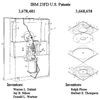1971: Floppy disk loads mainframe computer data
Small, removable flexible disks replace punched cards and paper tape




In 1967, product manager Alan Shugart at IBM, San Jose, assigned David L. Noble to lead the development of an inexpensive system for loading microcode into the controller for the IBM 3330 "Merlin". IBM shipped the first units of Noble’s solution, the 23 FD “Minnow” in 1971. The 8-inch floppy disk drive with removable read-only, flexible "memory disks” offered a storage capacity of 80 kilobytes (KB), approximately 3,000 punched cards. Other key contributors to the project were Warren L. Dalziel, lead inventor of the floppy drive, and Ralph Flores and Herbert Thompson who designed a special cleaning jacket that protected the 8-inch disk from damage. IBM adapted its punched card data entry machines so data could be loaded onto disks instead of paper. Larger capacity 500 KB Double Sided Single Density (DSSD) disks were introduced in 1976. A 1.2 MB format followed in 1977.
Shugart moved to Memorex and in 1972 the company introduced the Model 650 Flexible Disk File read/write drive and an 8-inch 175 KB media disk for general-purpose storage applications. In 1973 he founded Shugart Associates (SA). Microcomputer software entrepreneur Gary Kildall at Digital Research, Pacific Grove, CA used an SA800 8-inch floppy drive to develop his Control Program for Microcomputers (CP/M) operating system in 1974. Kildall's innovative BIOS (Basic Input, Output System) allowed CP/M to operate across a wide range of machines from different manufacturers and stimulated the use of floppy drives by small business and hobbyist computer users. SA pioneered the next generation 5.25” mini-floppy in 1976.
Contemporary Documents
- Flores, et al. "Magnetic Record Disk Cover" U.S. Patent 3,668,658 (Filed: December 22, 1969 Issued: June 6, 1972)
- Dalziel, et al. "Data Storage Apparatus Employing a Single Magnetic Disk" U.S. Patent 3,678,481 (Filed: March 13, 1970 Issued: July 18, 1972)
More Information
- “Floppy Disks” Revolution Exhibit, Computer History Museum (2011)
- Memorex 650 Flexible Disk File OEM Manual (1972)
- Laws, David. “Gary Kildall and the 40th Anniversary of the Birth of the PC Operating System” @CHM Museum Blog (February 2014)
- Noble, David L. “Data Storage on Floppy Disks” in Eric D Daniel, C. Denis Mee, Mark H. Clark eds. Magnetic Recording: The First 100 Years, IEEE Press (199) p. 300
- “The Floppy Disk” (Retrieved on 1.12.15 from: http://www-03.ibm.com/ibm/history/ibm100/us/en/icons/floppy/)
- Pugh, Emerson W., et al. IBM's 360 and Early 370 Systems, Cambridge, MA: MIT Press, 1991. p. 513
- Pugh, Emerson W. “STARS: Creating Magnetic Disk Storage at IBM” IEEE Global History Network (Retrieved on 10.20.14 from: http://www.ieeeghn.org/wiki/index.php/STARS:Creating_Magnetic_Disk_Storage_at_IBM)
- “Milestones: The CP/M Microcomputer Operating System, 1974” Engineering and Technology History Wiki (Retrieved on 12.2.15 from: http://ethw.org/Milestones:The_CP/M_Microcomputer_Operating_System,_1974)
- Schoenherr, Steven. "History of Magnetic Recording" presented at IEEE Magnetics Society Seminar, UCSD (Nov. 5, 2002) (Retrieved on 11.5.14 from: http://www.aes.org/aeshc/docs/recording.technology.history/magnetic4.html)
Oral Histories
- “Alan Shugart: About the Floppy Disk” Revolution Exhibit, Computer History Museum (2011)
- “International Business Machines Corporation (IBM) 5.25 and 3.5 inch floppy drives oral history panel” Computer History Museum Oral History # 102657925 (2005-01-13)
- “International Business Machines Corporation (IBM) 8 inch floppy disk drives oral history panel” Computer History Museum Oral History # 102657926 (2005-05-17)
1971_Floppy_v4
Rev: 12.2.15


